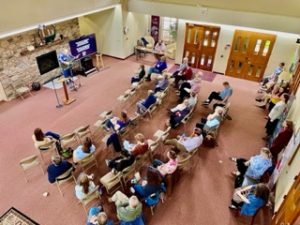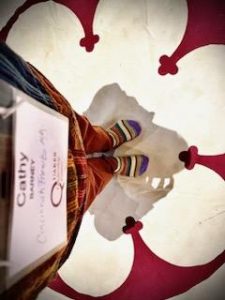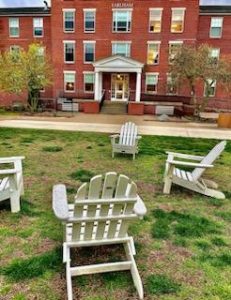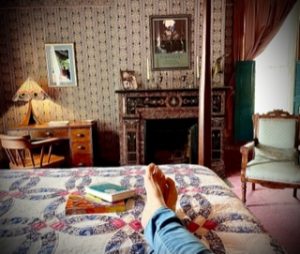Cathy Barney is Cincinnati Friends Meeting's Nurturer for Spiritual Growth and Outreach.

More than 60 Quakers from all branches gathered April 27-29 at the Earlham School of Religion (ESR) for the first Quaker Leadership Conference to discern the decline of our faith in North America. The conference was organized by the Quaker Leadership Center, funded by a Lilly Endowment grant, to equip Quaker leaders to adapt to rapid congregational and cultural change.
Parker Palmer Advises Quakers to Band Together
Author and teacher Parker Palmer, originally scheduled live, but speaking via Zoom on the advice of his doctor, opened the conference by suggesting our future is as “a movement not an established church.” Palmer’s topic was All Real Living is Meeting: Close Encounters of the Quaker Kind. “If we, as Quakers, could band together,” Palmer said, “we could move ourselves and the world forward.”
By widely sharing our “tested ways and practices, Quakers can heal people, communities and the world.” Palmer cautioned that those efforts “are best learned by experience,” in person in a safe and nurturing space. He proposed using the “Circles of Trust” developed at his Center for Courage and Renewal as vehicles for introducing the principles of Quakerism more widely.
When we feel overwhelmed or separated, Palmer said, we should revisit the Quaker concept of continuing revelation, borrowing a cue from Black activists to “remember our ancestors and that we are part of a legacy,” then do as God leads us. “We must continue to keep nourishing and serving because it creates an energy of attraction.”
When asked about increasing diversity among Quakers, Palmer responded: “As white Quakers, we suppress our differences, where the true diversity lies. Like in the '60, we can roll up our sleeves and WORK alongside Blacks and Catholics and any others. That doesn't mean we have to WORSHIP together.”
In attracting newcomers and young-adult Quakers, Palmer said, we must be open and inviting “in a world of experience that is beyond words and that newcomers may not yet understand. We can open up intergenerational dialogue to discuss our suffering together. None of us feels on firm ground.”
(Re)imaginging 100 People in Worship
Like Parker Palmer, Executive Secretary of FWCC, Section of the Americas Robin Mohr advocated for consolidation among Quakers, suggesting

struggling meetings merge. Mohr touted George Fox’s brilliance in developing a simple structure of monthly, quarterly and yearly meetings, “but in the past 20 years they have become an insupportable burden in the US.
“There is a mutual sense of superiority in that meetings would rather close than merge,” Mohr added. “We need an angel of merging, working together to make fully functioning meetings. Why can’t we imagine a meeting with 100 people worshiping?"
Covenant Relationship Best Inoculation
Traveling Friend Emily Provance of Fifteenth Street Meeting in New York pushed for Quakers to strengthen the marginal spaces she inhabits by “walking along the web of meetings. If we only connect to our monthly and yearly meetings, our diversity is limited.”
“In our current culture war,” Provance said, “Friends are not all on the same page. Covenant relationship is our best inoculation against culture wars.”
She advocates having tea and working together, which she borrowed from the book “The Culture Map” by Erin Meyer, as ways to mend differences. ”If we have tea and work together, we find how God is leading us,” according to Provance. “Why stop at the yearly meeting?
Extend the invitation to close-by meetings and strengthen the web. Cross institutions; what does covenant community look like to the institutional structure? God’s call is to the entire Religious Society of Friends.”
Surrendering to Spirit’s Desire for Recreation
Amid shrinking meetings, divisions, the isolation of Covid and woes of the world, Wichita University Friends Church Pastor Charity Sandstrom prompts Quakers to surrender to the recreative power of Spirit. The pastor illustrated this transformation using the story of Ezekiel (37:1-14) in the valley of dry bones with God, noting themes of reality, recreation, proclamation and home.

Initially, Sandstrom said, Ezekiel feels the weight of his struggling community without being heard, understanding he must surrender the situation to Spirit. “No one meeting or person can save Quakerism,” Sandstrom said. “Can we surrender the outcome? When we encounter the living God, we can trust her desire to recreate us.”
God's command for Ezekiel to breathe life into the bones signals “a return to hope and the divine intention to bring life,” according to Sandstrom. “Friends are dry,” Sandstrom said, “and Christ is here to teach us himself. We are cut off completely by the pandemic, family and meeting divisions, yet God offers hope to the hopeless” in scripture and real life.
Sandstrom places her faith in showing up in third spaces, where the unchurched are hungry for “community, relationship and connection. The little things [conversations over coffee, hosting cookouts in her yard] can make a difference.”
“Reality, recreation, proclamation and home are ways to build community,” Sandstrom said.
Leaders Matter; Separations Nurture Ideas
Retiring ESR historian Thomas Hamm, a frequent speaker at CFM, offered ways forward by examining the lessons from Quakers during periods of tumult. The 1650s were a period of upheaval with a sense of expectancy. The 19th Century was a time of separation and division and, during the 20th Century, Quakers experienced reunions of those divisions with overarching organizations such as Friends World Committee for Consultation (FWCC), Friends Committee on National Legislation, Pendle Hill Quaker Center and ESR.
The lessons, Hamm said, are:
- “Leaders matter; God can inspire anyone to lead anything and we should be open to the ways God calls different people to lead; and
- “Separations are not always bad. They cause pain and the reason may not be evident at the time, but some separations are a way of preserving and nurturing different ideas that would otherwise be lost.”
High Point NC Friends Meeting Senior Pastor Scott Wagoner echoed Hamm’s point that leadership among Friends “matters. Leadership needs to be named, it starts from and points to the divine.” In his short, but provocative talk, Wagoner ended by asking: “What intersection do you stand at, to be the change and hope in the world and help people connect to the divine?”
Young Adult Quakers Forge Hope in New Spaces
ESR Assistant Professor of Hebrew Bible Juliana Smith offered early research on the “formal informal” venues young adult Quakers are forging that are flexible and accessible. These gatherings happen away from meetinghouses, needy committees and weaponizing of Quaker process. Young adults desire to embrace their Quaker roots, live the testimonies and not just be accepted as LBGTQIA+, but understood.
As a result, Smith said, “These young adult Friends, who grew up in meetings, have responded in groups of caring well for the casualties of Quaker violence in informal groups with no brick and mortar.” They meet for “Beer and Quakers,” move into the same neighborhoods, gather on Facebook and meet in public, outdoor spaces to accommodate those who work multiple jobs and have little discretionary income or the space to host others.
During Smith’s workshop, Lloyd Lee Wilson, Quaker writer and minister, reminded the group that “we are a covenant community, and corporate mysticism, not individual mysticism, is our gift. We’re not willing to be present with others until the last half of life. Where is the broader sense of commitment? We have an absence of people holding the space, a challenge to nurture the meeting into the tradition. We need elders who know the tradition to hold the meeting in prayer.”
Smith said meetings have been successful including younger Friends with varying forms of worship sharing, worship sharing prior to worship, invitations to Bible study and a meal in someone’s home and online connection.
Keys to Reaching Young Quakers
Janaki Spickard Keeler, a Quaker writer and family therapist who stewards the Pendle Hill Pamphlet series, offered insight into reaching young Quakers.

“Learning and engagement among young and older Quakers should work both ways,” Keeler said. “We should empower, elder and mentor those younger as well as being truly accepting of LBGTQIA+ Friends, using their pronouns and language.” These Friends are particularly interested in worship, as well as different ways to enter into silence with multiple and flexible times.
Keeler collaborated with Shannon Isaacs, CFM member Marjorie Isaacs’ daughter and a frequent attender, in collecting data on attracting and retaining young adult Quakers.
Keeler highlighted meetings that appoint high school students to committees, leadership positions and service work, learning alongside adults, as ways forward. Older Friends can “be comfortable with the noise and chaos of kids and ask curious questions.” Keeler also suggested Quakerism 101 for young Friends, online spiritual mentorships, shorter task-oriented committee assignments, naming gifts, and “being overtly informational” about steps to worship, processes and committee structures.
My Take: Conference Theme Is Connecting in “Third Spaces”
After listening to Parker Palmer, a half-dozen other speakers and attending three workshops, the bottom line for me is that Quakers must carve out the “third” spaces – free from the meetinghouse and rigid process – to build community. We can specifically share the experiences of worship and our testimonies, meeting people where they are and helping them connect to the divine in our peculiar way. Elder, mentor, nurture.
Quakers have inner and outer work to undertake if we wish to remain vital. In addition to creating those third spaces, we need to transcend our boundaries and differences to be a movement that is nimble, not weighed down by meetinghouses and committee structures. In fact, during worship, I received the message “Yield our encumbrances.” We should look to the diversity already in our meetings and be especially attentive to young adult Quakers who want to be seen, included and respected as LBGTQIA+ persons.
I venture to identify the current stage of Quakers in North America, based on Thomas Hamm’s presentation, as maintaining our identity while working together to share our common practices with the larger world in creating balance, community and divine connection.
Click here to download the Epistle written to capture the 2023 Quaker Leadership Conference.
